The Decked Canoe Archives
Assembled by Tim Gittins
Detailing Mab: Charles E. Archibald's Gilbert Built Racer
An excerpt from "Champion Canoes of Today" by R. B. Burchard, Outing, 1897
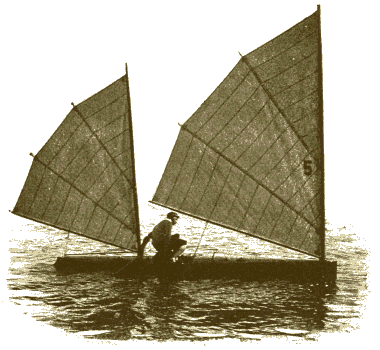 |
"Mab," showing sail plan. |
THERE are two schools of canoeists, and the pendulum of their respective popularities swings now in one direction, now in the other. Neither of them is likely to entirely supplant the other, for each of them. in its own sphere meets distinct want. There be those of the old school to whom the canoe is the faithful companion and friend on all the silent highways; who turn to it, year by year, as the trusty and well-loved transport to the heart of nature. On the other hand, there be those whose inventive skill is constantly exercised in the development of the highest form of naval design, and whose adventurous seamanship is satisfied with nothing but the excitement of personal prowess, the do and dare of fierce competition and the glory that crowns the successful contestant. But this impulse, during the past four years, had somewhat over-reached itself, and had failed to hold its original power, probably for the reason that the demands upon the racing man had become too exacting as the sport had grown more refined.
There is no prettier work afloat than canoe handling; but, as it is now, it requires the mental skill of the boat sailor with the physical skill of the gymnast, and unfortunately there are few possessing the ability who are willing to devote themselves to so absorbing a sport. So long as there are half a dozen devotees who practically live in the canoe houses from the spring thaw to the autumn frost, the occasional sailor has no chance in the trophy races. He drops out of racing altogether, and is apt to adopt that method of canoeing which affords him the most fun at the least expenditure of effort. The incentive of emulation being gone the racing canoemen became lazy.
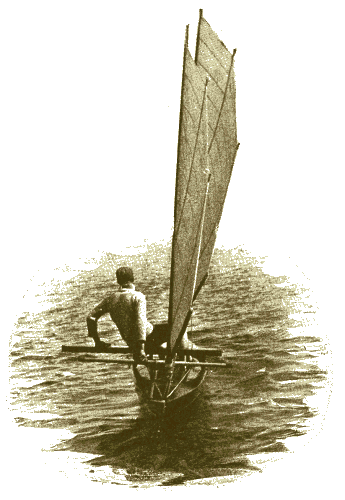 |
"Mab," showing steering-gear - Flat sliding seat. |
This state of thing's in the canoe world naturally roused apprehensions in the minds of those to contests most inclined, and the rule makers attempted to correct its tendency by limiting sail area. The result was similar to the effect of like restrictions in yacht racing; it did but stimulate the construction of a type of boat to meet the new conditions, and the restriction of sail area brought into existence the boat of lighter displacement.
It was these circumstances which, at the American Canoe Association meet at Grindstone Island last season, brought out the Mab, owned by Charles E. Archbold, of the Royal Canadian Yacht Club. This boat having been built of the lightest possible construction, light displacement and shoal draught, and being sailed by one of the best canoe sailors, easily defeated the older and heavier canoes. There are many novel and interesting points about this canoe. It was designed and built by N. Gilbert, of the Gilbert Boat Company, of Brockville, Ontario. The length of the boat is sixteen feet over all, the beam thirty inches, and the depth eleven inches inside, amidships. The flat floor, common in racing canoes for many years, is abandoned, and the new boat's midship section shows a marked dead-rise, as was the case in Mr. Barney's famous Pecowsic. The keel is nearly straight, the bottom plank almost straight. The stem and stem posts are plumb, and they both meet the keel at nearly a right angle. The stem is out of water when the canoe is at rest.
The widest part of the canoe is at the fore end of the well, or about eight feet from the bow. There is no sheer to the deck-line, the gunwale being nearly the same height above the water amidships as it is at the bow and stern. The sliding-seat is five feet three inches long, and is raised eight inches above the deck.
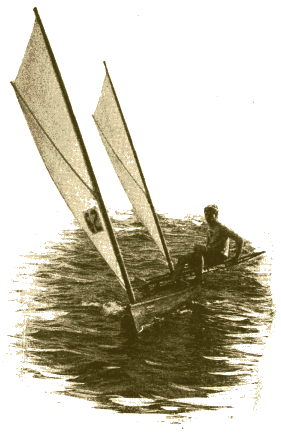 |
"Pioneer," showing truss sliding seat. |
The foremast is stepped about eight inches from the stem-head, and therefore, being shallow, it is supported above the deck by a circular wood block or collar, about eight inches in diameter and three inches in thickness. The sails, which are of union silk, are of the standing bat's-wing pattern, fitted with two battens from luff to leech, the total sail area being 126 square feet. The storm sails contain ninety square feet. As in nearly all the modern racing canoes, the sails neither reef nor lower. The spars are hollow, the pine sticks being cut in two, vertically, the two halves gouged out and then fastened together.
The hull is of ribband-carvel construction with white-cedar planking and deck, there being three planks to a side, running from end to end, one-eighth of an inch in thickness (three-sixteenths before finishing).
The centerboard is a thin plate of steel of the Linton Hope pattern.
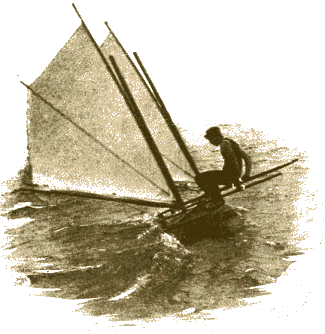 |
Under reefed sails. |
Everything about the boat is studied with a view to lightness, the weight or ballast consisting of the crew, who is perched outside of the boat to windward, on the end of his five-foot sliding-seat, and manoeuvers the craft by means of a five-foot thwartship tiller.
The ability to carry sail in such a light contrivance, depends entirely upon the skill of the canoeman; and so long as the boat carries sail and is held right side up, it will skim over the water, borne by a breath that would scarcely move a heavier boat.
The Mab is built with the modern small shallow cockpit, whose floor is above the centerboard trunk, so that any water which enters runs out through the centerboard trunk. The cockpit is three feet long, eighteen inches wide, and five and a half inches deep. The centerboard slot bisects the whole cockpit, and runs twenty-five and a half inches forward of it and five inches aft. The centerboard itself is a Linton Hope dagger, straight on the fore edge and curved on the after edge. It, as well as the rudder, is made of fourteen gauge steel, tempered and trued. The board is three feet six inches long and eighteen inches wide. The centerboard trunk is made long so that the board may be dropped at any desired point, forward or aft.
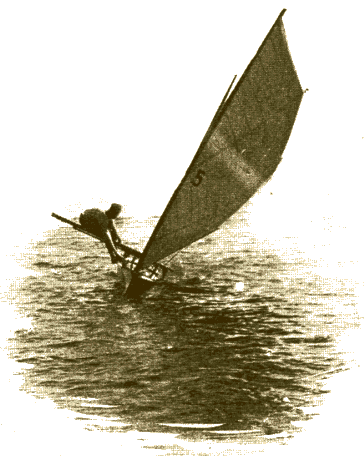 |
Belaying sheets. |
A noteworthy feature of the construction of the Mab is her high sliding seat, which is raised upon strong supports to a height of eight inches above the deck. The stationary part of the seat is supported not only in the usual method on the deck itself, but also upon blocks inside the coaming of the well, which rest upon a truss-work, that is in turn supported upon bases which rest upon the ribs of the boat in either bilge.
The Butler tiller slides in a horizontal collar which is, in turn, fastened to a vertical collar which encircles the mizzen mast after the usual fashion. The construction of the brass collar is original, however. The photograph of the canoe, stem on, shows the arrangement of the sliding-seat, the deck tiller, and the "Norwegian" tiller. The latter is a device adapted from the Norwegian fishing boats, a number of which were on view at the Chicago exhibition. By this contrivance, instead of rudder lines or chains, a long stick is toggled to one end of the rudder yoke; the other end reaches away forward in the boat, so that the occupant thereof may grasp the stick and steer the craft from any part to which the steering stick may reach.
In the Mab and other canoes employing this device, the stick is toggled at one end to the rudder yoke, and at the other to the collar of the deck tiller. The advantage is that it is always taut, and never hanging loose; and it may be pulled or pushed, so that a single stick upon one side will serve the purpose of two rudder lines.
The fittings of the Mab are original, varnished rawhide frequently taking the place of brass. The fair leaders on deck are simply brass thimbles bound with rawhide. Stiff pieces of rawhide are also found to serve as cleats.
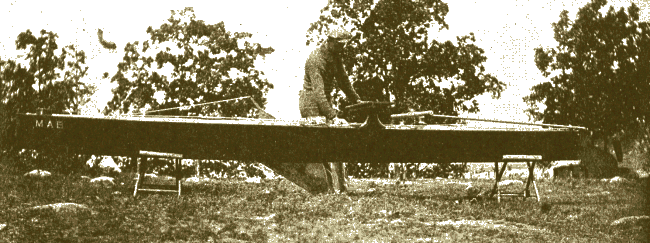 |
"Mab," showing sheer plan. |
The rig of the Mab is so simple as to need no explanation, the photographs being self-explanatory. The sails being fast to the mast, there is only one line to each. This is the sheet, which is double-ended, reeving through fair leaders so as to be readily reached from the sliding-seat upon either side of the canoe. The sheet is held by a cam cleat, the cam being provided with a long lever which may be operated by the toe of the skipper when he is so far out on the seat that the canoe can only be reached by that member. Thus, when a squall strikes, he leans far out on the end of the seat which has been extended far over the seething water. If he sees that, even with the leverage of the whole seat, he cannot hold up the canoe, he may slip a cam cleat with his toes, let the sheet go, and ease the vessel while the flaw passes.
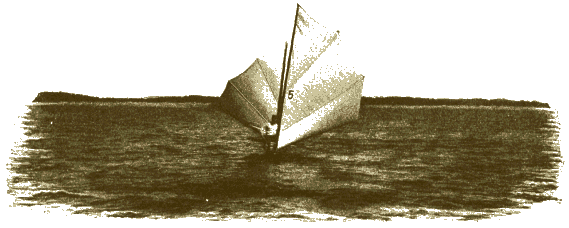 |
"Mab," down the wind. |
Ulrike_veerkamp.jpg)
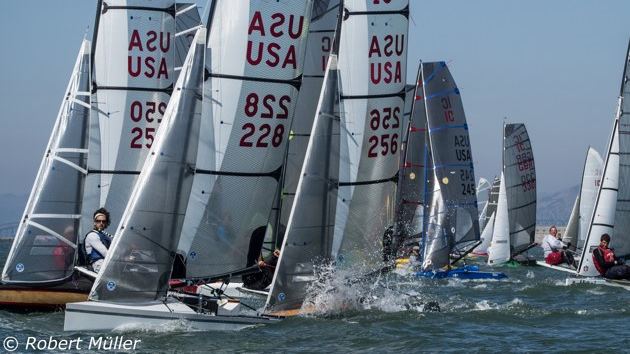
Ulrike_veerkamp.jpg)
Ulrike_veerkamp.jpg)
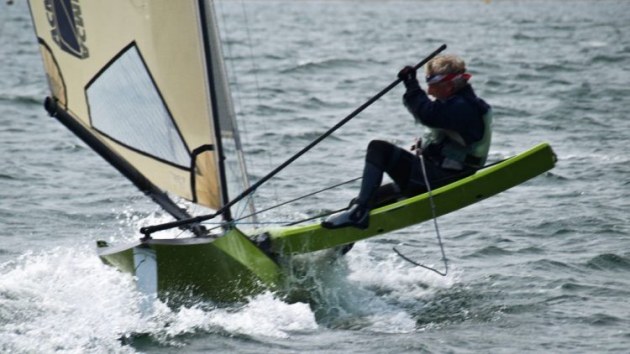



Ulrike_veerkamp.jpg)
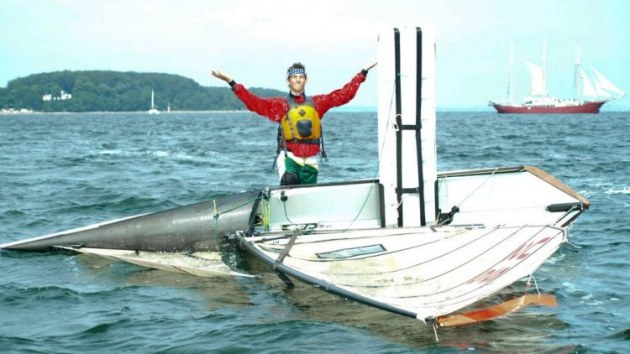
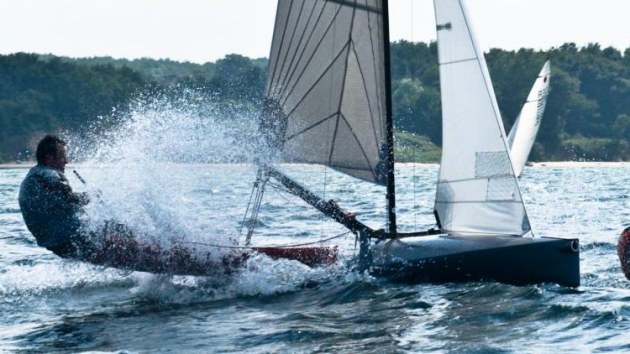
Ulrike_veerkamp.jpg)